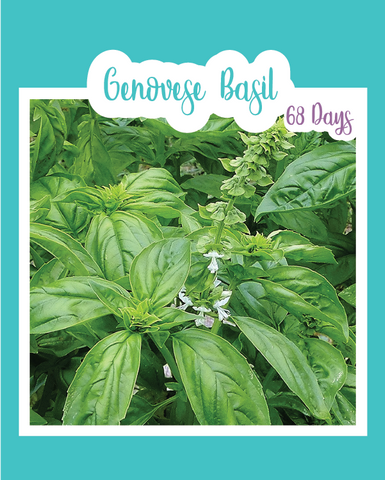
Italian Large Leaf Basil
Seed Count: Approx. 300 seeds
Days to Maturity: 80 Days
Description: This popular Basil variety has the largest leaves of any other basil variety. Its sweet, spicy flavor can be used in a wide variety of ways in the kitchen. It can be cooked, eaten fresh, or used in tea. I personally love to dry my basil and add it to everything I cook for that special oomph. Plants grow 24" to 32" tall, with large green leaves that are 2" to 4" long. The scent and taste is sweet and mild, and it is very attractive to bees, and butterflies.
Mint2Grow Tip: I like to plant my basil between my tomato plants. It makes a good defense against hornworms, and I've noticed significantly less of them when I do this. Basil makes for a delicious tea by itself, which is kind of sweet and minty, or add it to a pot with lemongrass and mint for a Caribbean styled "bush tea".
How To Grow
Sowing: Since basil loves warm weather, it grows best when the soil has warmed and there is no chance of frost. In cool climates, start seeds indoors 3-4 weeks before the last frost, sowing them thinly and providing heat to speed up the germination. Transplant 15-18" apart. To direct sow, plant the seeds 1/4" deep, in rich soil and full sun, thinning to 15-18" apart when the seedlings develop. Basil also grows well indoors or as a container plant.
Growing: Basil needs well draining soil, yet needs to be watered often. If the weather drops below 50 degrees, provide protection. As the plant grows, pruning it helps it to develop into a bushy, healthy plant; pruning is also important because once the plant flowers, it will begin to wilt and die. To prune the plant, remove the top several sets of leaves on each stem, taking care to leave at least three sets of leaves on the lower part. Try planting basil with tomatoes. It will help deter tomato hornworms by masking the tomato plants’ smell.
Harvesting: Basil can be harvested as soon as it reaches a height of 6-8". The best time to harvest the leaves are in the morning after the dew dries. After the plant is established, harvesting often actually improves production; once the flowers develop, the leaves grow bitter in taste. Remove single leaves or parts of a stem as needed, taking care to leave at least three sets of leaves on the length of the stem for healthy growth. Fresh basil will keep for several days at room temperature, with the stems in a glass of water; if refrigerated, it tends to wilt and turn brown. Basil also freezes and dries well. Dry by using a dehydrator, an oven, or by hanging and drying in a dry, warm location.




